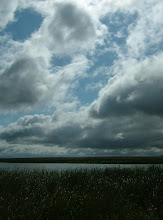She sold houses. She was good at it. I had worked for her sister and her sister lied like a flounder so when the sister told me she won the top sales award nearly every month, so much that she hardly ever went to the awards banquets anymore, so much that the other sales people in the office were jealous of her, I was skeptical. But one day, long after the accident, I was looking for a kitchen
utensil of some sort in her kitchen and opened one of the deep bottom drawers and it was filled with plaques. There were easily dozens of them in there. All the monthly awards and a bunch of annuals ones on bigger plaques.
She was working into the evening on a Friday, between Christmas and New Year's, a slow time for house sales, but you never knew when some young couple would get the hankering to take a look at the models, so she was there. She ran out for something, left a note on the door and took just her wallet, not even her whole purse or her coat. Cigarettes? A snack? Advil or eye drops? A magazine because it was that slow? Who know why she left the office, she certainly didn't remember. She was just going to zip across the street into the strip mall, apparently, and she didn't have her seat belt on, though reports varied as to whether that helped or harmed her. She probably looked both ways and then darted out in her little black car and SLAM! From out of nowhere, a big landscaper's pickup with snow plowing
hydraulics on the front bumper broadsided her little car, crushing, bending, twisting it and plowing it along the street up onto the curb. It was dusk and witnesses said he did not have his headlights on, so it was probably in that period
between light and dark where the shadows and lights play tricks and maybe she just didn't see him. Some witnesses said he was speeding, but they might have just been piling on because they were angry with him. They said she was thrown into the other side of the car and people helped her out of the passenger side and helped find her wallet for the police and ambulance attendants. They said she was out and walking around and talking. By the time the ambulance got her to the emergency room, her brain was swelling from the sudden impact and they put her into a coma to minimize the effects of the
concussion. They found oh so many injuries, a broken pelvis and a broken ankle and bruises and scrapes and long later, after weeks in the hospital and more in in-patient rehab and many more in outpatient
rehab, she was still having wrist pain, so they x-
rayed and found a break that had never healed because it was never
immobilized. The physical wounds eventually mostly healed but her brain never did. She could still sell houses like
nobody's business, but she got the paperwork wrong. Or told them the wrong numbers. Or just didn't get the paperwork done at all. They gave her a secretary, but she gave the
secretary wrong information or forgot to tell the secretary to do things. Or forgot to show up for meetings or appointments. In the end, they let her go. Too many angry customers who thought they had a deal in the works and didn't, or some detail was wrong at closing and so it fell through. She bounced from job to job, worked a while even for the dry cleaner who cleaned her fancy suits and blouses for years. And oh, yeah, she didn't have health insurance because she was supposed to be on her husband's as part of the divorce agreement many years before but about 2 months before the accident, he got tired of paying it and dropped her. So the medical bills bankrupted her. Oh, yeah, and while she was in the hospital and rehab, her sister went to pharmacies and picked up her pain
meds 'for her' and kept them, so when she'd go to get them, they'd be gone. And she'd worry that she'd lost them or was losing her mind.
There is a prairie at the
rehab center. I have always wanted to see it, and today, on my way to pick up drafting supplies for a project I didn't want to work on indoors, I stopped there. Wandered the prairie, listened to the dried grasses rustling in the wind, watched the birds dart about the seed heads of the dried
prairie flowers. And remembered it all.
There is no lesson. It just happened. It was terrible. I did what I could for her, but in the end, no amount if visiting and running errands and supportive phone calls can fix a broken brain. I don't know where she is. She moved so many times because she could
not make the rent and each time, she was embarrassed to tell me. We exercised at the gym together and kept having lunch and then she stopped calling or answering calls or emails. I miss her. I heard she is living with her mother. I don't know her mother's name. I have searched for her on-line. I have lost her. I miss her.
 Very different people, very different areas they study,
Very different people, very different areas they study,
























